
THE IFBB CALIFORNIA PRO FIGURE
CHAMPIONSHIPS
Culver City, CA – May
29th
By Bill Dobbins
The 2002 California Pro Fitness was held this year in conjunction with the NPC California Championships – giving the audience a chance to see the IFBB pro fitness women in addition to the best of the California male and female amateur physique competitors. This presented somewhat of a challenge to the promoters, since the backstage facilities at the Veteran's Auditorium in Culver City are fairly limited. You couldn't move around backstage without rubbing up against beautiful, oiled-up female bodies. (This is a complaint, you ask?) But the show managed to go off without any problems nonetheless.
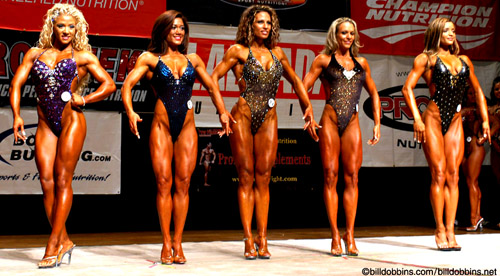
This contest turned out to be an interesting experiment in figure judging. While figure judging at competitions like the Arnold and the Olympia has been relatively consistent, the question remains╔why? With no real "standards" that judges can use to place competitors, how have they managed to be as uniform as they have been in their placings up to this point? Jenny Lynn or Davana Medina as winners, Monica Brant a close runner up, women like Elaine Goodlad and Mari Kudla-Donnely somewhere in the top five.
It isn't as if the judges got together and decided beforehand on how to vote. There is no evidence of that (although there is constant discussion going on among the judges, which looks bad and violates both IFBB and NPC rules). And at the national/international level you don't see the spectacle of head judges and/or district chairmen deciding on their own what call outs will be made, in what order the competitors stand on stage and putting pressure on judges if their scores deviate from these clear cut "hints" as to how the contest should be judged.
In the past, I have made two observations about figure judging:
- Like fitness, the judges tend to look at who has won in the past and use these competitors as standards by which to judge future contests.
- With some exceptions (such as in the case of Monica Brant, for example) figure is NOT fitness without the performance round. Rather, figure judges tend more to look for "fitness models," women who have proportions that include longer waists and legs, looking more like athletic models than smaller bodybuilders – the prototypes for this look being Jenny Lynn and Davana Medina.
But the panel tends to be composed of largely the same judges in major contests like Columbus and Las Vegas so it is not so surprising that the outcomes tend to be similar. However, the judging panel in Culver City contained a number of judges who do not normally officiate in the bigger events. Of course, these judges were familiar with most of the pro figure competitors at the California so no doubt they already had opinions and knew who the "favorites" would be. But you would expect that a somewhat different panel of judges, in a competition like figure - with no real "objective" standards - would come up with at least somewhat different scoring.
 To some degree, this is exactly what happened. The winner was Elaine
Goodlad, who had never won a pro figure show before but who has almost
always been in the top 5. Given that women like Jenny, Davana, and
Monica Brant were not in the field, it made sense for her to move up and
win the contest. Elaine is sometimes penalized because she
looks too much like a bodybuilder and not enough like a "model" for many
of the judges (but not for her fans) but the west coast judges didn't seem
bothered by her muscular but aesthetic physique.
To some degree, this is exactly what happened. The winner was Elaine
Goodlad, who had never won a pro figure show before but who has almost
always been in the top 5. Given that women like Jenny, Davana, and
Monica Brant were not in the field, it made sense for her to move up and
win the contest. Elaine is sometimes penalized because she
looks too much like a bodybuilder and not enough like a "model" for many
of the judges (but not for her fans) but the west coast judges didn't seem
bothered by her muscular but aesthetic physique.
Second place was Zena Collins. Zena is attractive and was in good
shape. But she doesn't have the "tall" proportions that characterize
the genetics of many figure champions. In fact, there were a number
of other competitors who seemed equally as attractive and in good shape. Why
did the judges pick Zena instead of somebody else? No particular
reason, I suspect. And no reason not to, either. Which is one
of the problems with figure as a "competition." If left to themselves
in a closed room with no communication with anyone else any given judge
might well place a competitor 12th that another has 1st – or
vice versa. After all, all these women are aesthetic and athletic. So
a Zena Collins is just as good a choice as a half dozen other attractive
and athletic-looking women out of the 22 entered in the show. 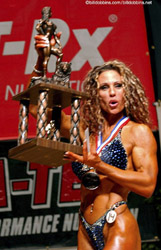 Whether
she does as well in bigger contests remains to be seen. But given
the tendency of judges to vote for women who have already been successful,
perhaps 2nd at the California Pro will give her future career
a boost.
Whether
she does as well in bigger contests remains to be seen. But given
the tendency of judges to vote for women who have already been successful,
perhaps 2nd at the California Pro will give her future career
a boost.
Amber Littlejohn placed third and she remains one of the most exotic and interesting looking women in figure. She has a fashion model's leggy proportions and is exactly the sort competitor who can sell magazines (her layout in Iron Man was a runaway success) and products in the fitness industry. Given her long, lean proportions Amber would probably look even better with a little more muscle. In the past she has said that is what she was working for. However, prior to the contest she moved from Northern California to Florida and that probably had a lot to do with the fact that she looked a little less muscular at the Pro California than in the past.
In fourth place was Sweden's Lena Johannesen. I have always felt that Lena should have stayed in bodybuilding, where she started. Certainly, the sport could always do with another Tonya Knight and Lena is beautiful and sexy enough to qualify. However, for reasons of her own she switched to fitness, where she was largely overlooked. Since moving on to figure competition, this is the first really good placing Lena has achieved. Whether she will continue to do well in bigger shows remains to be seen. Perhaps doing so well in Culver City will cause the rest of the IFBB judges to take her more seriously. Perhaps not. In any event, Lena has already proved she has "star quality" and can sell magazines, products and 8X10 photos so her career is likely to prosper whether or not she is able to win figure titles.
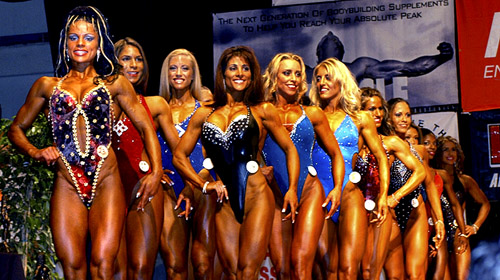
Kimberly Becker, who is another of those figure women who could easily have chosen bodybuilding, placed 5th. Kimberly has said in interviews that she gains muscle really easily. Since a lot of the figure women share this ability, you have to wonder where this type of competition is going to end up in 5 years. A lineup of long, lean junior bodybuilders? At least, we can probably expect it to last at least 5 years - unlike fitness, which is being squeezed out of existence by the inability of the federations to change the rules to allow competitors without high-level gymnastics skills to win titles. When you have five women entering fitness in NPC local shows and 75 (or more) in figure that should be sending a message to the rule makers.
One of the more interesting aspects of the judging was that Mari Kudla-Donnely, who has been in the top five in every pro figure contest that she has entered, finished in 7th place. Mari no doubt expected that, like Elaine Goodlad, she would move up in the standings in a smaller show where the "big guns" of the Arnold and the Olympia were not present. But it seems as if more local or regional judging panels (in the US, not in Europe) tend frequently to like seeing more muscle and muscular definition than do the "usual suspects" on the national judging panels. Mari definitely has an athletic body and she is one of the sexiest looking women in figure – with the kind of star quality that should put her in great demand for magazine covers and industry advertising – but she doesn't really have the level of physical development and definition that you see in many of her competitors. Mari should probably take a lesson from the success of Monica Brant, who remains muscular enough to compete as a lightweight bodybuilder. Everyone likes lots of muscle on women, as long the women are beautiful enough. If she can manage to look just a little bit more "like a bodybuilder" Mari should be able to stay near the top no matter who is on the panel of judges.

Speaking of bodybuilding – and fitness/figure women who are in the wrong kind of competition – it was interesting to see Italy's Lorena Cozza in the lineup. Unfortunately for Lorena, she finished in a tie for last place. But aside from the fact that none of the judges knew who she was (and, as we've discussed, past performance and publicity play a large role in determining how the judges score what is essentially a beauty contest), Lorena's main problem was that she looked like a terrific lightweight bodybuilder who should be competing against Juliette Bergmann or Dayana Cadeau rather than Amber Littlejohn. It's tough to be a female with muscle in Italy (which is why the IFBB has sometimes granted pro status to women bodybuilders from that country against the wishes of the national federation!). But Lorena should concentrate on bodybuilding – as should so many women in the US and around the world who belong in bodybuilding and are wasting their time, effort and genetic gifts trying to compete against fitness models.
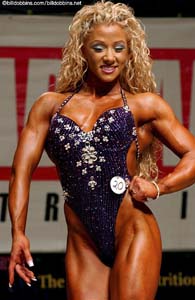 |
 |
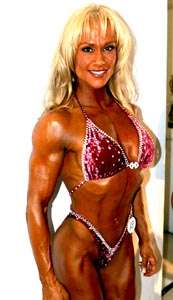 |
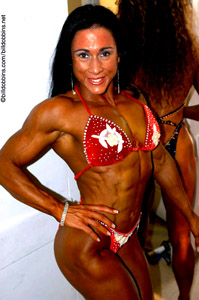 |
|
Mari Kudla-Donnely |
Amber Littlejohn |
Lena Johannesen |
Lorena Cozza |
As to the idea of combining a pro figure contest with an NPC state championship, or some other similar amateur competition, no doubt the idea was to provide a little extra excitement and "eye candy" to help sell tickets. Whether this strategy was an economic success or not is known only to the promoters. If they made money, or think they will make money in the future adding pro figure to their events, we will see this done more often. If not, we won't.
But it is well established that people don't want to pay money for figure or fitness – unless it is to see genuine STARS (and Elaine Goodlad certainly qualifies). So promoters in the IFBB and NPC, insofar as they have an influence on the policies of the federations, should be very concerned about rules that do not focus on creating and promoting female stars for the fitness industry. Bodybuilding has to be structured to allow the best competitor to win, no matter the consequences regarding promotion and publicity. With fitness and figure, having rules that create winners who can be promoted by the industry to make money for themselves, the magazines, the sponsors and everyone else involved should be a primary consideration.
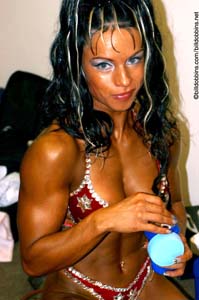 |
Inga Nenerayskaite |
One other aspect of the judging that should be considered is the lack of attention that many foreign competitors get - especially those who are more exotic and seem strange to judges whose taste runs more to "white bread" contestants. One example who comes to mind is Lithuania's Inga Nenerayskaite, who placed 19th at the California Pro Figure. Inga is exotic in a way that, say, Amber Littlejohn (who comes across much like a supermodel) is not. But Inga has a highly promotable (international) potential so it is hoped the judges will begin to give her more attention as they gradually get used to her.
COMPLETE PHOTO COVERAGE IN SUBSCRIBER AREA